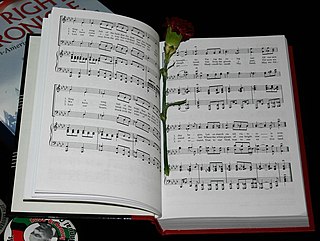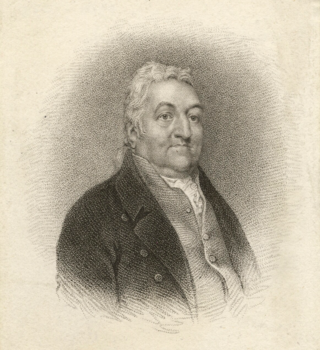
Francis Scott Key was an American lawyer, author, and amateur poet from Frederick, Maryland, best known as the author of the text of the U.S. national anthem, "The Star-Spangled Banner". Key observed the British bombardment of Fort McHenry in 1814 during the War of 1812. He was inspired upon seeing the American flag still flying over the fort at dawn and wrote the poem "Defence of Fort M'Henry"; it was published within a week with the suggested tune of the popular song "To Anacreon in Heaven". The song with Key's lyrics became known as "The Star-Spangled Banner" and slowly gained in popularity as an unofficial anthem, finally achieving official status more than a century later under President Herbert Hoover as the national anthem.

"The Star-Spangled Banner" is the national anthem of the United States. The lyrics come from the "Defence of Fort M'Henry", a poem written on September 14, 1814, by 35-year-old lawyer and amateur poet Francis Scott Key after witnessing the bombardment of Fort McHenry by British ships of the Royal Navy in Outer Baltimore Harbor in the Patapsco River during the Battle of Baltimore in the War of 1812. Key was inspired by the large U.S. flag, with 15 stars and 15 stripes, known as the Star-Spangled Banner, flying triumphantly above the fort during the U.S. victory.

"Lift Every Voice and Sing" is a hymn with lyrics by James Weldon Johnson (1871–1938) and set to music by his brother, J. Rosamond Johnson (1873–1954). Written from the context of African Americans in the late 19th century, the hymn is a prayer of thanksgiving as well as a prayer for faithfulness and freedom, with imagery that evokes the biblical Exodus from slavery to the freedom of the "promised land."

John Stafford Smith was a British composer, church organist, and early musicologist. He was one of the first serious collectors of manuscripts of works by Johann Sebastian Bach.
Allen Perdue Britton was an American music educator.

Music education is a field of practice in which educators are trained for careers as elementary or secondary music teachers, school or music conservatory ensemble directors. Music education is also a research area in which scholars do original research on ways of teaching and learning music. Music education scholars publish their findings in peer-reviewed journals, and teach undergraduate and graduate education students at university education or music schools, who are training to become music teachers.

"The Star Spangled Banner" is a charity single recorded by American singer Whitney Houston to raise funds for soldiers and families of those involved in the Persian Gulf War. Written by Francis Scott Key and John Stafford Smith, "The Star-Spangled Banner" is the national anthem of the United States. The musical arrangement for Houston's rendition was by conductor John Clayton. The recording was produced by music coordinator Rickey Minor, along with Houston herself. The recording was included in the 2014 CD/DVD release, Whitney Houston Live: Her Greatest Performances and the US edition of the 2000 release, Whitney: The Greatest Hits.
In the course of the adoption of "The Star-Spangled Banner" as the national anthem of the United States, a variety of people have either sung or performed the anthem using a variety of instruments and methods. Some of these methods include using only one instrument, such as a guitar or trumpet. Other methods have included singing the anthem using different vocal ranges or even changing some of the words to show support for a home team or for an event. However, veterans groups have spoken out on occasion about these recordings, mainly calling them disrespectful to the country and to the anthem.

American patriotic music is a part of the culture and history of the United States since its foundation in the 18th Century. It has served to encourage feelings of honor both for the country's forefathers and for national unity. They include hymns, military themes, national songs, and musical numbers from stage and screen, as well as others adapted from many poems. Much of American patriotic music owes its origins to six main wars — the American Revolution, the American Indian Wars, the War of 1812, the Mexican–American War, the American Civil War, and the Spanish–American War. During the period prior to American independence, much of the country's patriotic music was aligned with the political ambitions of the British in the new land. And so, several songs are tied with the country's British origin.
"Nuestro Himno" is a Spanish-language version of the United States national anthem, "The Star-Spangled Banner". The debut of the translation came amid a growing controversy over immigration in the United States.

The Star-Spangled Banner, or the Great Garrison Flag, was the garrison flag that flew over Fort McHenry in Baltimore Harbor during the naval portion of the Battle of Baltimore during the War of 1812. It is on exhibit at the National Museum of American History, Smithsonian Institution. Seeing the flag flying over Fort McHenry on the morning of September 14, 1814, after the battle ended, Francis Scott Key was inspired to write the poem "Defence of Fort M'Henry". These words were written by Key and set to the tune of "To Anacreon in Heaven", a popular song at the time, by John Stafford Smith. In 1931 the song became the national anthem of the United States.

Rene Rancourt is an American singer, who is best known for having performed the national Anthem(s) at home games of the National Hockey League's Boston Bruins for 42 years. Rancourt's final combined performance of both "The Star-Spangled Banner" and "O Canada" took place before Game 7 of the Bruins' Eastern Conference first round playoff series against the Toronto Maple Leafs on April 25, 2018. His final anthem performance, of "the Star-Spangled Banner" alone, took place on May 4, 2018 as Boston hosted Game 4 of the Eastern Conference second round series against the Tampa Bay Lightning.
David K. Hildebrand is a freelance performer, lecturer, recording artist, and longtime partner of Ginger Hildebrand ; he is an adjunct instructor at the Peabody Conservatory, and a widely recognized scholar of early American music history, including that of the colonial, Revolutionary, Federal and War of 1812 periods. He has focused especially on the music of Maryland. His dissertation was on the colonial music of Annapolis, and his masters thesis on musical instruments in that region up to the American Revolution.
The National Association for Music Education (NAfME) is an organization of American music educators dedicated to advancing and preserving music education as part of the core curriculum of schools in the United States. Founded in 1907 as the Music Supervisors National Conference (MSNC), the organization was known from 1934 to 1998 as the Music Educators National Conference. From 1998 to 2011 it was known as "MENC: The National Association for Music Education." On September 1, 2011, the organization changed its acronym from MENC to NAfME. On March 8, 2012, the organization's name legally became National Association for Music Education, using the acronym "NAfME". It has approximately 45,000 members, and NAfME's headquarters are located in Reston, Virginia.
Music and political warfare have been used together in many different political contexts and cultures as a way to reach a targeted audience in order to deliver a specific political message. Political warfare as defined by Paul A. Smith is the "use of political means to compel an opponent to do one's will... commonly through the use of words, images and ideas." Music is useful because it creates an easily recognizable and memorable method of delivery for the desired message. Music is particularly useful medium for the delivery of propaganda. Jacques Ellul stated that for propaganda to be effective it must "fill the citizen's whole day and every day". Since music is often viewed to be a leisure activity, it is often not considered to be as threatening as other propaganda techniques, and as a result messages can often be surreptitiously communicated without being conspicuously noticed.

Long considered a sacred cow of American defense spending, U.S. federal military bands have periodically faced the prospect of decreased allocations in military budgets in proposals occasionally floated by lawmakers of the U.S. Democratic and Republican parties. Defunding efforts have generally been opposed by military leadership, veteran's groups, and music educators, and have largely been unsuccessful and short-lived.

Jere T. Humphreys is an American music scholar who applies historical, quantitative, philosophical, and sociological research methods to music education and arts business.
David G. Hebert is a musicologist and comparative educationist, employed as Professor of Music at Western Norway University of Applied Sciences, where he leads the Grieg Academy Music Education (GAME) research group. He has contributed to the fields of music education, ethnomusicology, sociomusicology, comparative education, and East Asian Studies. Since 2018, he has been manager of the Nordic Network for Music Education, a multinational state-funded organization that sponsors intensive Master courses and exchange of university music lecturers and students across Northern Europe. He is also a visiting professor in Sweden with the Malmo Academy of Music at Lund University, and an honorary professor with the Education University of Hong Kong. He has previously been sponsored by East Asian governments as a visiting research scholar with Nichibunken in Kyoto, Japan, and the Central Conservatory of Music, in Beijing, China.
Alexandra Kertz-Welzel is Professor and Chair of Music Education at Ludwig-Maximilians-Universität in Munich, Germany. She studied at the Hochschule für Musik Saar and Saarland University in Saarbrücken, where she obtained Master's Degrees in music education, German studies, Philosophy, piano performance, and harpsichord performance, and was a scholarship holder from Cusanuswerk between 1992 and 2000. In 2000, she received a PhD degree in Musicology from Saarland University, with a dissertation on aesthetics in literature and music during the early romanticism in the Nineteenth century. Prior to her employment at LMU Munich in 2011, she was lecturer in music education at the Hochschule für Musik in Saarbrücken (2005–2011), and visiting scholar and lecturer in music education at the University of Washington in Seattle, Washington (2002–2005).

Lucy Monroe was an American operatic soprano and dancer. She was noted for her performances of "The Star-Spangled Banner", the national anthem of the United States, which she performed for Presidents and at sporting and military events, which earned her the nickname of "The Star-Spangled Soprano".











